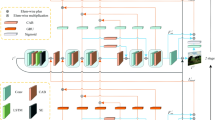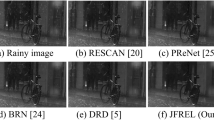Abstract
Single-image deraining is challenging due to the lack of temporal information. Current methods based on deep neural networks have achieved good performance in this task. However, these methods are still less effective in handling complex rainy situations. In this paper, we propose Channel-attention-based Multi-scale Recurrent Residual Network (CMRRNET), which tries to fully exploit contextual information of rainy images from multiple aspects. First, we construct a hybrid feature extraction module, which consists of the dilated convolution block and the multi-scale convolution block, to fully obtain image feature information. Second, we adopt the residual channel attention mechanism which makes the network aware of the importance of different channels. Third, we introduce long short-term memory to extract the correlation information of the features between different stages. We conduct extensive experiments on both synthetic and real rainy images. Ablation studies and extensive comparisons with state-of-the-art methods demonstrate the effectiveness of our CMRRNET.







Similar content being viewed by others
References
Zhang X, Li H, Qi Y, Leow WK, Ng TK (2006) Rain removal in video by combining temporal and chromatic properties. In: 2006 IEEE international conference on multimedia and expo, pp 461–464
Kim J-H, Sim J-Y, Kim C-S (2015) Video deraining and desnowing using temporal correlation and low-rank matrix completion. IEEE Trans Image Process 24(9):2658–2670
Liu J, Yang W, Yang S, Guo Z (2018) Erase or fill? Deep joint recurrent rain removal and reconstruction in videos. In: Proceedings of the IEEE conference on computer vision and pattern recognition, pp 3233–3242
Chen J, Tan C-H, Hou J, Chau L-P, Li H (2018) Robust video content alignment and compensation for rain removal in a CNN framework. In: Proceedings of the IEEE conference on computer vision and pattern recognition, pp 6286–6295
Kang L-W, Lin C-W, Fu Y-H (2012) Automatic single-image-based rain streaks removal via image decomposition. IEEE Trans Image Process 21(4):1742–1755
Luo Y, Xu Y, Ji H (2015) Removing rain from a single image via discriminative sparse coding. In: Proceedings of the IEEE international conference on computer vision, pp 3397–3405
Chen Y-L, Hsu C-T (2013) A generalized low-rank appearance model for spatio-temporally correlated rain streaks. In: Proceedings of the IEEE international conference on computer vision, pp 1968–1975
Zhang H, Patel VM (2017) Convolutional sparse and low-rank coding-based rain streak removal. In: 2017 IEEE winter conference on applications of computer vision, pp 1259–1267
Li Y, Tan RT, Guo X, Lu J, Brown MS (2016) Rain streak removal using layer priors. In: Proceedings of the IEEE conference on computer vision and pattern recognition, pp 2736–2744
Kim J-H, Lee C, Sim J-Y, Kim C-S (2013) Single-image deraining using an adaptive nonlocal means filter. In: 2013 IEEE international conference on image processing, pp 914–917
He K, Zhang X, Ren S, Sun J (2016) Deep residual learning for image recognition. In: Proceedings of the IEEE conference on computer vision and pattern recognition, pp 770–778
Huang G, Liu Z, Van Der Maaten L, Weinberger KQ (2017) Densely connected convolutional networks. In: Proceedings of the IEEE conference on computer vision and pattern recognition, pp 2261–2269
Hu J, Shen L, Sun G (2018) Squeeze-and-excitation networks. In: Proceedings of the IEEE conference on computer vision and pattern recognition, pp 7132–7141
Yu F, Koltun V (2016) Multi-scale context aggregation by dilated convolutions. In: International conference on learning representations
Yang W, Tan RT, Feng J, Liu J, Guo Z, Yan S (2017) Deep joint rain detection and removal from a single image. In: Proceedings of the IEEE conference on computer vision and pattern recognition, pp 1685–1694
Li X, Wu J, Lin Z, Liu H, Zha H (2018) Recurrent squeeze-and-excitation context aggregation net for single image deraining. In: Proceedings of the European conference on computer vision, pp 262–277
Ren D, Zuo W, Hu Q, Zhu P, Meng D (2019) Progressive image deraining networks: a better and simpler baseline. In: Proceedings of the IEEE conference on computer vision and pattern recognition, pp 3932–3941
Yang W, Liu J, Yang S, Guo Z (2019) Scale-free single image deraining via visibility-enhanced recurrent wavelet learning. IEEE Trans Image Process 28(6):2948–2961
Fu X, Huang J, Zeng D, Huang Y, Ding X, Paisley J (2017) Removing rain from single images via a deep detail network. In: Proceedings of the IEEE conference on computer vision and pattern recognition, pp 1715–1723
Zhang H, Patel VM (2018) Density-aware single image de-raining using a multi-stream dense network. In: Proceedings of the IEEE conference on computer vision and pattern recognition, pp 695–704
Li G, He X, Zhang W, Chang H, Dong L, Lin L (2018) Non-locally enhanced encoder-decoder network for single image de-raining. In: Proceedings of the 26th ACM international conference on multimedia, pp 1056–1064
Jiang K, Wang Z, Yi P, Chen C, Huang B, Luo Y, Ma J, Jiang J (2020) Multi-scale progressive fusion network for single image deraining. In: Proceedings of the IEEE/CVF conference on computer vision and pattern recognition, pp 8346–8355
Zhu H, Wang C, Zhang Y, Su Z, Zhao G (2020) Physical model guided deep image deraining. In: 2020 IEEE international conference on multimedia and expo, pp 1–6
Wang C, Xing X, Wu Y, Su Z, Chen J (2020) DCSFN: deep cross-scale fusion network for single image rain removal. In: Proceedings of the 28th ACM international conference on multimedia, pp 1643–1651
Yasarla R, Patel VM (2020) Confidence measure guided single image de-raining. IEEE Trans Image Process 29:4544–4555
Deng S, Wei M, Wang J, Feng Y, Liang L, Xie H, Wang FL, Wang M (2020) Detail-recovery image deraining via context aggregation networks. In: Proceedings of the IEEE/CVF conference on computer vision and pattern recognition, pp 14560–14569
Qian R, Tan RT, Yang W, Su J, Liu J (2018) Attentive generative adversarial network for raindrop removal from a single image. In: Proceedings of the IEEE conference on computer vision and pattern recognition, pp 2482–2491
Zhang H, Sindagi V, Patel VM (2020) Image de-raining using a conditional generative adversarial network. IEEE transactions on circuits and systems for video technology, pp 3943–3956
Zhao Y, Zhai D, Jiang J, Liu X (2020) ADRN: attention-based deep residual network for hyperspectral image denoising. In: ICASSP 2020–2020 IEEE international conference on acoustics, speech and signal processing, pp 2668–2672
Xingjian S, Chen Z, Wang H, Yeung D-Y, Wong W-K, Woo W-c (2015) Convolutional LSTM network: a machine learning approach for precipitation nowcasting. In: Advances in neural information processing systems, pp 802–810
Szegedy C, Vanhoucke V, Ioffe S, Shlens J, Wojna Z (2016) Rethinking the inception architecture for computer vision. In: Proceedings of the IEEE conference on computer vision and pattern recognition, pp 2818–2826
Zhang Y, Li K, Li K, Wang L, Zhong B, Fu Y (2018) Image super-resolution using very deep residual channel attention networks. In: Proceedings of the European conference on computer vision, pp 286–301
Huynh-Thu Q, Ghanbari M (2008) Scope of validity of PSNR in image/video quality assessment. Electron Lett 44(13):800–801
Wang Z, Bovik AC, Sheikh HR, Simoncelli EP (2004) Image quality assessment: from error visibility to structural similarity. IEEE Trans Image Process 13(4):600–612
Paszke A, Gross S, Chintala S, Chanan G, Yang E, DeVito Z, Lin Z, Desmaison A, Antiga L, Lerer A (2017) Automatic differentiation in pytorch. In: NIPS autodiff workshop: the future of gradient-based machine learning software and techniques
Kingma DP, Ba J (2015) Adam: a method for stochastic optimization. In: International conference on learning representations
Wei C, Wang W, Yang W, Liu J (2018) Deep retinex decomposition for low-light enhancement. In: British machine vision conference
Guo X, Li Y, Ling H (2016) LIME: low-light image enhancement via illumination map estimation. IEEE Trans Image Process 26(2):982–993
Zhang Y, Zhang J, Guo X (2019) Kindling the darkness: a practical low-light image enhancer. In: Proceedings of the 27th ACM international conference on multimedia, pp 1632–1640
Guo Y, Wu Z, Shen D (2020) Learning longitudinal classification-regression model for infant hippocampus segmentation. Neurocomputing 391:191–198
Chen L, Wu Z, Hu D, Wang Y, Mo Z, Wang L, Lin W, Shen D, Li G, Consortium UUBCP (2020) A deep spatial context guided framework for infant brain subcortical segmentation. In: International conference on medical image computing and computer-assisted intervention, pp 646–656
Hao S, Zhou Y, Guo Y (2020) A brief survey on semantic segmentation with deep learning. Neurocomputing 406:302–321
Liu L, Ouyang W, Wang X, Fieguth P, Chen J, Liu X, Pietikäinen M (2020) Deep learning for generic object detection: a survey. Int J Comput Vis 128(2):261–318
Acknowledgements
This work is partially supported by the National Key Research and Development Program of China under Grant 2019YFA0706200, the National Nature Science Foundation of China under Grants 61772171, 61632007, 61876056, the Fundamental Research Funds for the Central Universities under Grants PA2020GDKC0023, PA2019GDZC0095, and the Shanghai Philosophy and Social Science Planning Project under Grant A1713.
Author information
Authors and Affiliations
Corresponding author
Additional information
Publisher's Note
Springer Nature remains neutral with regard to jurisdictional claims in published maps and institutional affiliations.
Rights and permissions
About this article
Cite this article
Cao, X., Hao, S. & Xu, L. Single Image Deraining by Fully Exploiting Contextual Information. Neural Process Lett 54, 2613–2627 (2022). https://doi.org/10.1007/s11063-021-10486-x
Accepted:
Published:
Issue Date:
DOI: https://doi.org/10.1007/s11063-021-10486-x




